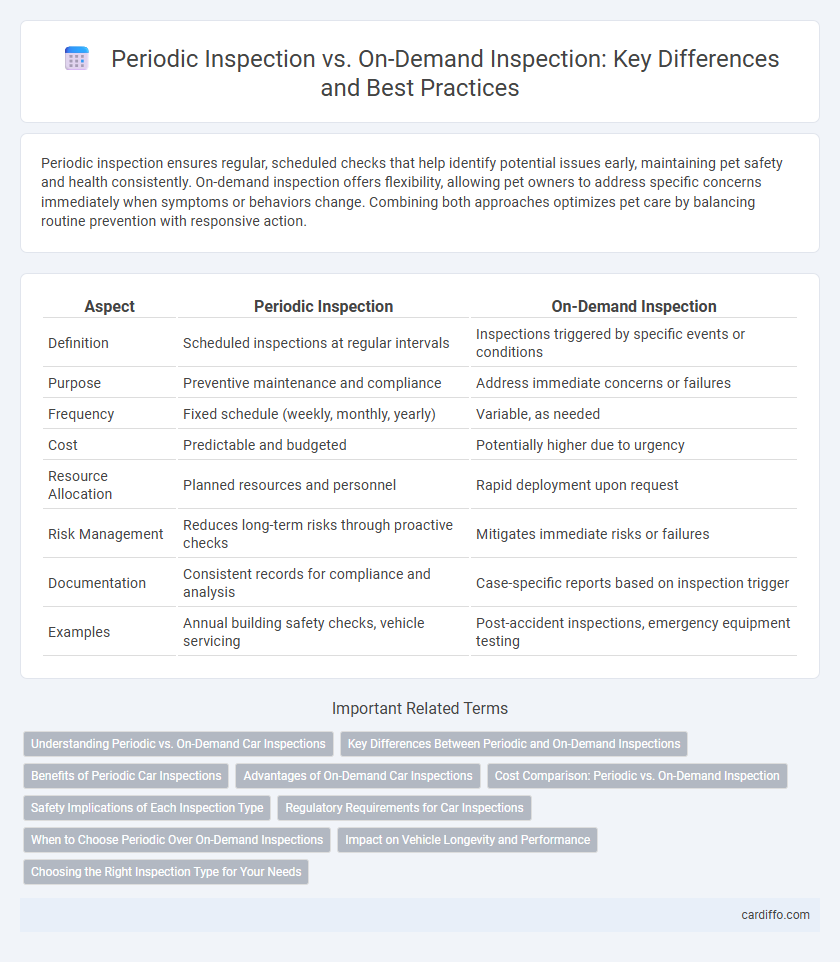Periodic inspection ensures regular, scheduled checks that help identify potential issues early, maintaining pet safety and health consistently. On-demand inspection offers flexibility, allowing pet owners to address specific concerns immediately when symptoms or behaviors change. Combining both approaches optimizes pet care by balancing routine prevention with responsive action.
Table of Comparison
| Aspect | Periodic Inspection | On-Demand Inspection |
|---|---|---|
| Definition | Scheduled inspections at regular intervals | Inspections triggered by specific events or conditions |
| Purpose | Preventive maintenance and compliance | Address immediate concerns or failures |
| Frequency | Fixed schedule (weekly, monthly, yearly) | Variable, as needed |
| Cost | Predictable and budgeted | Potentially higher due to urgency |
| Resource Allocation | Planned resources and personnel | Rapid deployment upon request |
| Risk Management | Reduces long-term risks through proactive checks | Mitigates immediate risks or failures |
| Documentation | Consistent records for compliance and analysis | Case-specific reports based on inspection trigger |
| Examples | Annual building safety checks, vehicle servicing | Post-accident inspections, emergency equipment testing |
Understanding Periodic vs. On-Demand Car Inspections
Periodic car inspections involve scheduled evaluations based on time or mileage intervals to ensure vehicle safety, emissions compliance, and performance consistency. On-demand inspections occur as needed, often triggered by specific concerns such as unusual noises, accidents, or dashboard warnings, providing targeted diagnostics. Understanding these inspection types helps optimize maintenance schedules and prevent unexpected breakdowns by balancing routine checks with reactive assessments.
Key Differences Between Periodic and On-Demand Inspections
Periodic inspections occur at scheduled intervals based on regulatory requirements or industry standards, ensuring consistent compliance and early detection of potential issues. On-demand inspections are conducted in response to specific concerns, incidents, or client requests, offering flexibility and targeted problem-solving. The key differences lie in timing, purpose, and triggers: periodic inspections are routine and preventive, while on-demand inspections are reactive and situational.
Benefits of Periodic Car Inspections
Periodic car inspections ensure consistent monitoring of vehicle safety and performance, reducing the risk of unexpected breakdowns and costly repairs. Regular inspections help identify wear and tear early, maintaining compliance with safety regulations and enhancing roadworthiness. This proactive approach increases vehicle longevity and provides peace of mind for drivers.
Advantages of On-Demand Car Inspections
On-demand car inspections provide immediate, flexible assessments tailored to specific concerns, enabling timely identification of potential issues before they escalate. These inspections can be scheduled as needed, reducing unnecessary costs associated with routine periodic checks when no problems are present. Furthermore, on-demand inspections support informed decision-making in situations such as pre-purchase evaluations or after accident repairs, enhancing vehicle safety and reliability.
Cost Comparison: Periodic vs. On-Demand Inspection
Periodic inspections typically incur higher upfront costs due to scheduled, routine checks regardless of equipment condition, whereas on-demand inspections optimize expenses by targeting only when issues arise. Over time, on-demand inspections can reduce maintenance costs by minimizing unnecessary downtime and resource allocation. However, periodic inspections may prevent costly failures through early detection, potentially saving more in long-term repair and safety compliance fees.
Safety Implications of Each Inspection Type
Periodic inspections systematically identify potential safety hazards by ensuring equipment and systems meet established standards at regular intervals, reducing the risk of unexpected failures. On-demand inspections address immediate safety concerns triggered by observed anomalies or incidents, providing prompt risk mitigation but potentially missing hidden or developing defects. Balancing these inspection types maximizes safety by combining routine preventative checks with responsiveness to emerging issues.
Regulatory Requirements for Car Inspections
Periodic inspections are mandated by regulatory authorities to ensure vehicles comply with safety and emissions standards at scheduled intervals, typically annually or biannually. On-demand inspections occur in response to specific concerns or incidents, such as accidents or suspected violations, and must also adhere to regulatory criteria set by transportation departments or environmental agencies. Both inspection types require certified inspectors and documentation to maintain legal roadworthiness and avoid penalties.
When to Choose Periodic Over On-Demand Inspections
Periodic inspections are ideal when consistent monitoring is required to ensure long-term safety and compliance, especially in regulated industries like manufacturing and aviation. Choosing periodic inspections helps detect potential issues early by adhering to a fixed schedule based on equipment usage or time intervals. On-demand inspections are less effective for preventing routine wear and tear but useful for addressing unexpected problems or failures.
Impact on Vehicle Longevity and Performance
Periodic inspection ensures consistent maintenance schedules, significantly enhancing vehicle longevity and sustained performance by identifying wear and tear before failures occur. On-demand inspection addresses specific issues as they arise, which can prevent immediate breakdowns but risks missing early signs of damage that affect long-term durability. Implementing a balanced approach that prioritizes periodic inspections maximizes engine efficiency, reduces unexpected repairs, and maintains optimal vehicle condition over time.
Choosing the Right Inspection Type for Your Needs
Periodic inspections involve scheduled evaluations at regular intervals to ensure ongoing compliance and safety, making them ideal for routine maintenance and long-term asset management. On-demand inspections are performed as needed in response to specific issues or incidents, offering flexibility for immediate problem resolution and targeted assessments. Selecting the right inspection type depends on factors such as regulatory requirements, risk levels, operational downtime tolerance, and the criticality of the inspected asset.
Periodic inspection vs on-demand inspection Infographic

 cardiffo.com
cardiffo.com